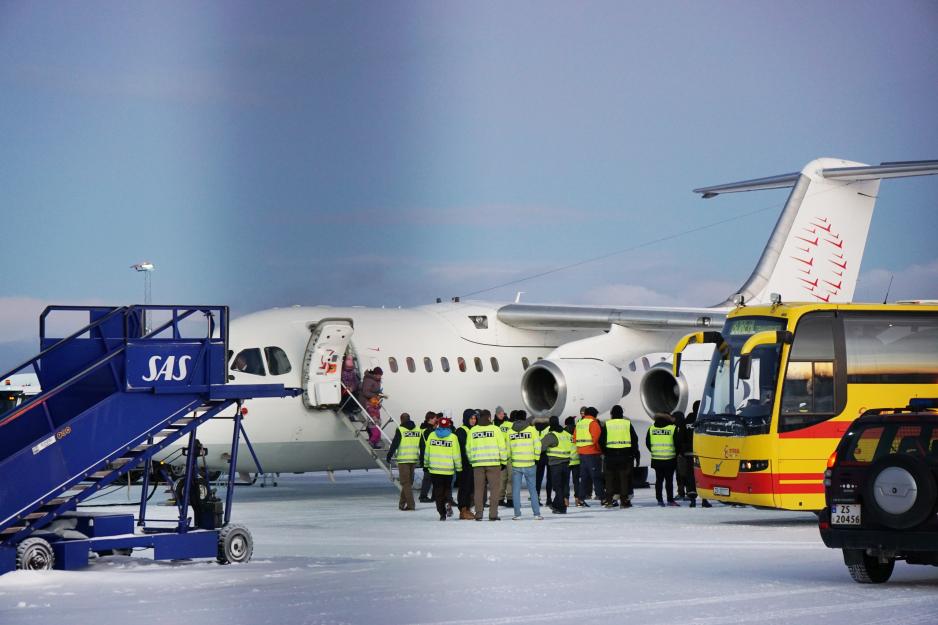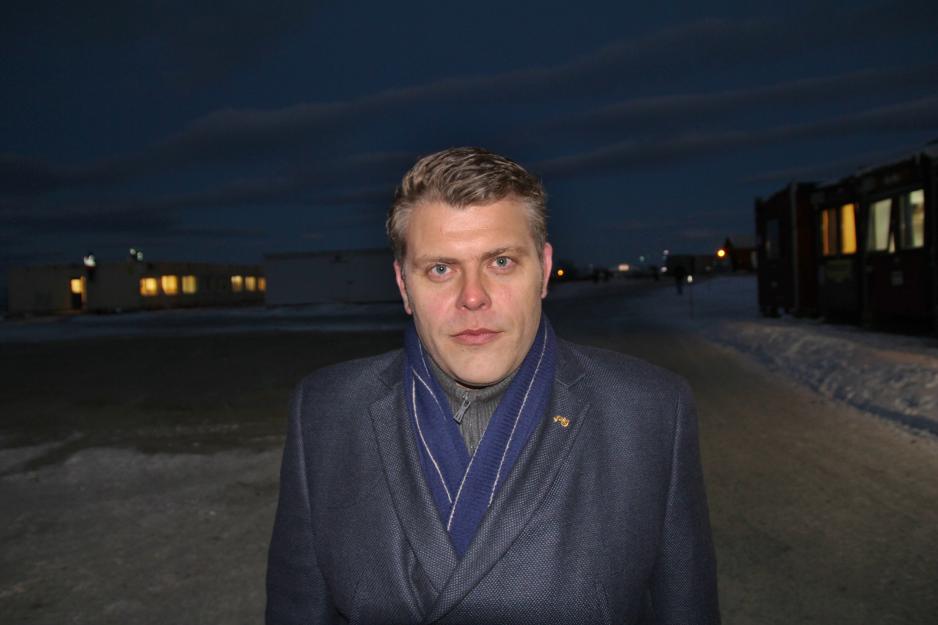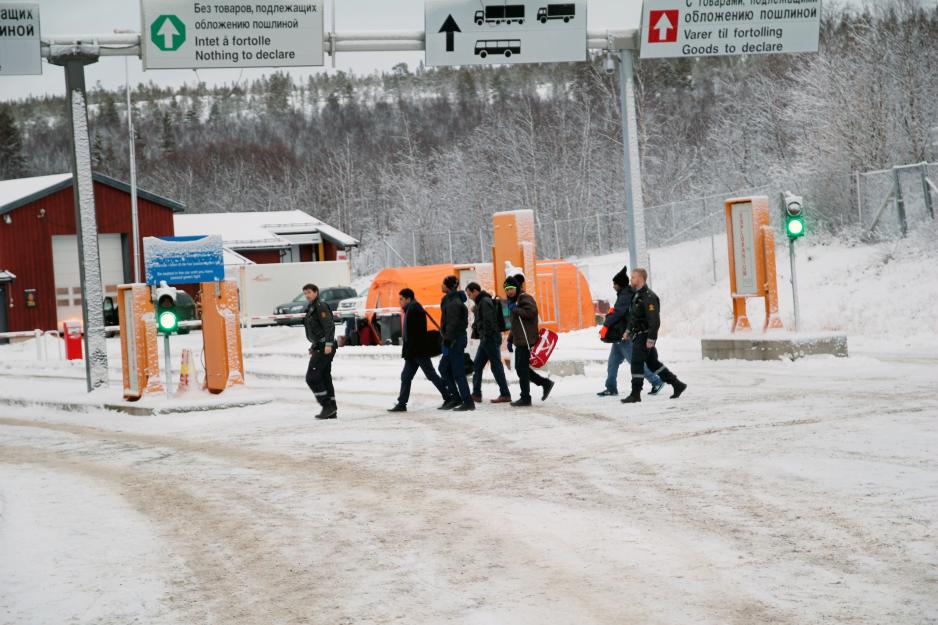Increasing Number of Storskog Migrants Disappear After Being Denied Asylum

In December 2015, Norwegian authorities started returning asylum seekers who had entered the country across the Norwegian-Russian border at Storskog. Here, a plane from Trondheim has arrived at Kirkenes airport. The persons on board the plane were returned the way they came. Photo: Stian Strøm/NRK
Nearly 2,500 of the asylum seekers who entered Norway across the Norwegian-Russian border at Storskog, Finnmark county during the fall of 2015, and who have had their asylum applications denied, have disappeared. The police does not know where they are and says there are few people left in Norway who can be transported out.
During a few busy autumn weeks in 2015, almost 5,000 people crossed the Norwegian-Russian border at Storskog, Finnmark and applied for asylum in Norway. Some 2,000 of them have had their applications granted, whereas 3,420 applications have been rejected or dismissed, according to figures from the Norwegian Directorate of Immigration (UDI).
Recent statistics from the National Police Immigration Services (NPIS) shows that only 27 percent of the Storskog applicants without valid permission to stay in Norway have been transported out from the country. This equals 950 persons.
This means that a whopping 2,470 persons have disappeared.
Kallmyr does not want to answer
Jøran Kallmyr (Progress Party) was State Secretary at the Ministry of Justice and Preparedness in the autumn of 2015. During a visit to Finnmark Arrival Center on 11 November, he went far in promising that most of the people arriving across the border at Storskog were to be expedited out from the country rather quickly.
“Many of the people who are here now, will not get permission to stay in Norway. However, the first thing we had to prioritize was getting roofs over their heads. It is winter here, and six degrees Celsius below zero. Now, we are ready to start the massive process of denying applications for people who get here”, Kallmyr said to Norwegian news agency NTB.
High North News has tried for several days to get a comment from current Minister of Justice and Preparedness Jøran Kallmyr, however, without succeeding.
The MPIS will not comment on whether they are planning further returns of asylum seekers from the so-called Storskog portfolio due to “police operational considerations”.
“We know that many have been registered as disappeared during the past three years, and most of them have presumably left the country”, the MPIS writes in an email to High North News.

Then-State Secretary Jøran Kallmyr (Progress Party) visited Finnmark Arrival Center in November 2015. Photo: Amund Trellevik/NRK Finnmark
Asylum seekers via Storskog
A total of 5,439 persons arrived across the Storskog border crossing point during the period of 19 January to 29 November 2015 and applied for asylum. One person arrived on 22 September 2016.
As of 1 January 2019, 946 Storskog arrivals from the above mentioned period were transported out with an annual distribution as follows:
2105: 367 persons
2016: 479 persons
2017: 74 persons
2018: 26 persons
The National Police Immigration Services (MPIS) says less than 10 persons have been transported out from the country so far in 2019.
“Many disappear”
In 2015 and 2016, 367 and 479 persons respectively from what the police describes as ‘the Storskog portfolio’ have been transported out, whereas the numbers have plunged from 2017 (see fact box).
The Police Directorate in a letter to the Ministry of Justice and Preparedness says “the main reason for the low number is the fact that man disappear from their known address”.
“There are thus few persons left from the Storskog portfolio who can be transported out”, the Police Directorate writes.
At the year’s end, some 110 so-called Storskog cases were left in the NPIS portfolio. 20 of these are pending, while 80 persons have disappeared. Most returns in 2017 and 2018 were made possible through the Dublin cooperation, i.e. a person who originally filed his or her asylum application in Norway, was detained in another country and sent to Norway prior to being transported out from the country.
High North News has asked the National Police Immigration Service to comment on the current status for out-transporting of the so-called Storskog asylum seekers who have had their applications rejected.
“During 2019, fewer than 10 foreign nationals arriving via Storskog in 2015 have been transported out. Some of these may have been expelled or forced to leave after being disappeared from Norway, been granted permission to stay in a safe third country and transported out to a safe third country, where they currently reside. We have not separated these cases from the Storskog statistics”, the NPIS writes in an email to High North News.
Senior Advisor Jon Ole Martinsen at the Norwegian Organisation for Asylum Seekers (NOAS) is well acquainted with the Storskog cases. He says some of the people who have disappeared from Norway after their applications were rejected have traveled on to their European networks.
- Many of them have networks and families in other European countries. Many also wanted their applications to be processed in countries like Sweden or Germany, countries that left a public image or wanting to care for the refugees who arrived in Europe at that time, Martinsen says.
He also argues that the people who used the Arctic route as an access point to Norway did not have Norway as their end destination. Their final destinations was somewhere else, just like the many who arrived in Greece and Italy, but who wanted to go further north in Europe.
Martinsen argues that the chaos at Storskog was created by Norwegian authorities and that is has led to a difficult situation for many people.
“The original plan was to return them to Russia, and it took a long time before the people had their applications processed in Norway. That has been a contributing factor for many choosing to move on, Martinsen says.
Many returned from Germany
The NPIS says the main part of out-transports in 2017 and 20018 are subject to so-called ‘Dublin returns’. Nearly half of all ‘Dublin returns’ have stayed in Germany, according to NPIS figures.
A Dublin return means that the authorities of one country, in most cases Germany, arrest any asylum seeker with an expulsion decision from Norway and returns the person to Norway before Norway, in turn, transports the person out to a third country.
“In addition, Norway has received a high number of requests to take persons back to Norway, without this having resulted in return to Norway due to the persons’ disappearing or lack of arrest in the European countries in question, the NPIS reports.
Many people who go from Norway to other European countries in reality go into hiding and chose not to file another application for asylum, Martinsen of NOAS says.
“We have seen examples on people not registering with the immigration authorities in the country in which they reside. They prefer to wait, hoping that there will be a greater chance of having one’s new application processed in the new country. One is thus vulnerable towards negative structures such as work life exploitation and an easy target for criminal networks. Persons without legal permission to stay and without any opportunity to work must stain themselves. And then the road to crime is very short, Martinsen says.

The police receiving asylum seekers at Storgskog in the fal of 2016. Photo: Amund Trellevik
This article was originally published in Norwegian and has been translated by HNN's Elisabeth Bergquist.

